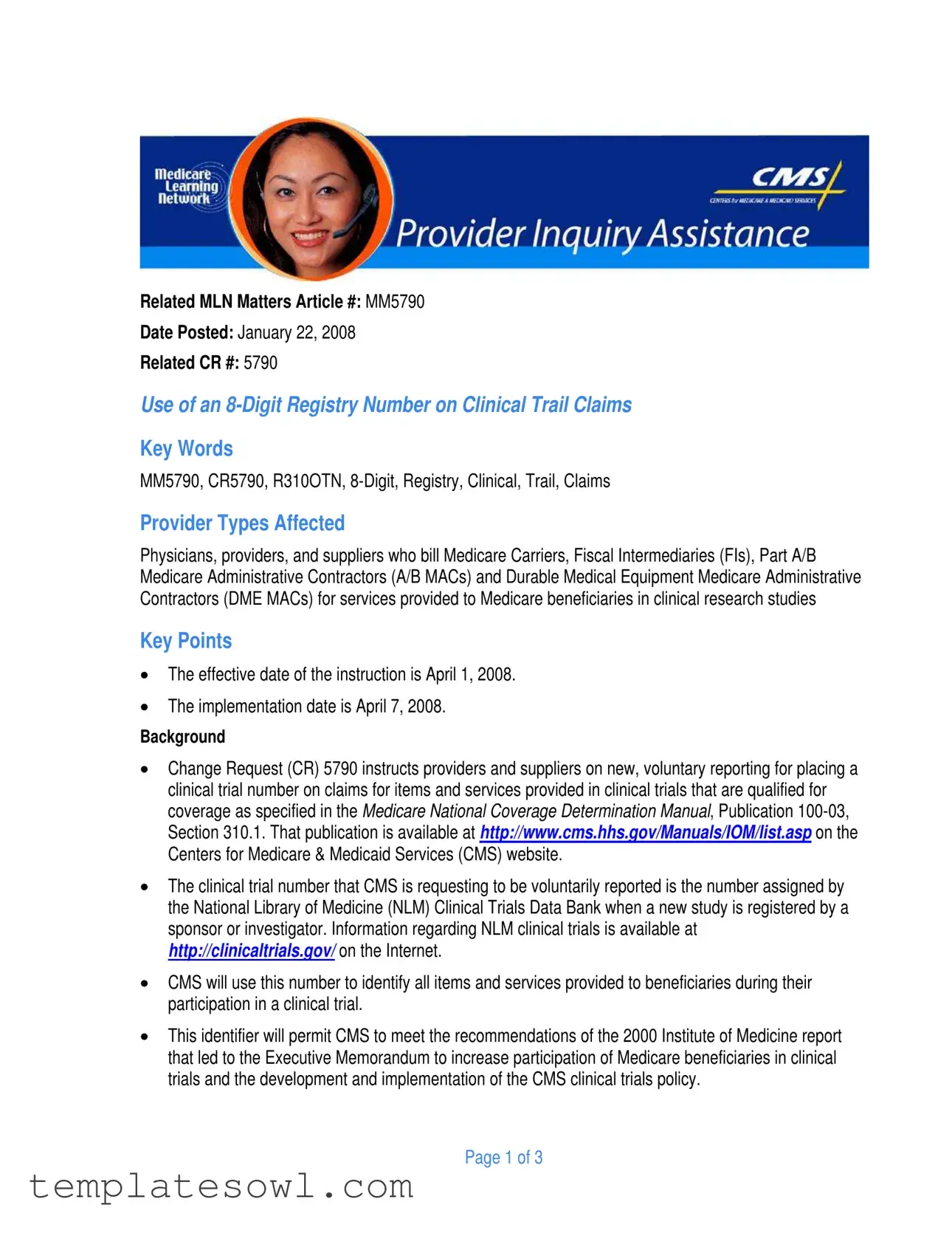Related MLN Matters Article #: MM5790
Date Posted: January 22, 2008
Related CR #: 5790
Use of an 8-Digit Registry Number on Clinical Trail Claims
Key Words
MM5790, CR5790, R310OTN, 8-Digit, Registry, Clinical, Trail, Claims
Provider Types Affected
Physicians, providers, and suppliers who bill Medicare Carriers, Fiscal Intermediaries (FIs), Part A/B Medicare Administrative Contractors (A/B MACs) and Durable Medical Equipment Medicare Administrative Contractors (DME MACs) for services provided to Medicare beneficiaries in clinical research studies
Key Points
•The effective date of the instruction is April 1, 2008.
•The implementation date is April 7, 2008.
Background
•Change Request (CR) 5790 instructs providers and suppliers on new, voluntary reporting for placing a clinical trial number on claims for items and services provided in clinical trials that are qualified for coverage as specified in the Medicare National Coverage Determination Manual, Publication 100-03, Section 310.1. That publication is available at http://www.cms.hhs.gov/Manuals/IOM/list.asp on the Centers for Medicare & Medicaid Services (CMS) website.
•The clinical trial number that CMS is requesting to be voluntarily reported is the number assigned by the National Library of Medicine (NLM) Clinical Trials Data Bank when a new study is registered by a sponsor or investigator. Information regarding NLM clinical trials is available at http://clinicaltrials.gov/ on the Internet.
•CMS will use this number to identify all items and services provided to beneficiaries during their participation in a clinical trial.
•This identifier will permit CMS to meet the recommendations of the 2000 Institute of Medicine report that led to the Executive Memorandum to increase participation of Medicare beneficiaries in clinical trials and the development and implementation of the CMS clinical trials policy.
Page 1 of 3
Related MLN Matters Number: MM5790
•Recommendations from The White House Executive Memorandum included:
•Tracking Medicare payments;
•Ensuring that the information gained from the research is used to inform coverage decisions;
•Making certain that the research focuses on issues of importance to the Medicare population; and
•Enabling CMS to better inform Medicare beneficiaries about the clinical studies available for their participation.
•Claims submitted without the clinical trial number will be paid the same as claims containing a number.
•Institutional clinical trial claims are identified through the presence of all of the following elements:
•Value Code D4 and corresponding 8-digit clinical trial number (when present on the claim);
•International Classification of Diseases, Ninth Revision (ICD-9) diagnosis code V70.7;
•Condition Code 30; and
•Healthcare Common Procedure Coding System (HCPCS) modifier Q1: outpatient claims only. (See MLN Matters article MM5805 related to CR5805 for more information regarding modifier Q1.)
•Practitioner/DME clinical trail claims are identified through the presence of all of the following elements:
•ICD-9 diagnosis code V70.7;
•HCPCS modifier Q1; and
•8-digit clinical trial number (when present on the claim).
•On institutional claims, the 8-digit numeric clinical trial number should be placed in the value amount of value code D4 on the paper claim UB-40 (Form Locators 39-41) or in Loop 2300, HI – Value Information segment, qualifier BE on the 837I.
•On professional claims, the clinical trial registry number should be preceded by the two alpha characters of “CT” and placed in Field 19 of the paper Form CMS-1500 or it should be entered WITHOUT the “CT” prefix in the electronic 837P in Loop 2300 REF02(REF01=P4).
Important Links
The related MLN Matters article can be found at http://www.cms.hhs.gov/MLNMattersArticles/downloads/MM5790.pdf on the CMS website.
The official instruction (CR5790) issued regarding this change may be found at http://www.cms.hhs.gov/Transmittals/downloads/R310OTN.pdf on the CMS website.
Providers may see the article related to the Q1 modifier (MM5805) at http://www.cms.hhs.gov/MLNMattersArticles/downloads/MM5805.pdf on the CMS website.
Related MLN Matters Number: MM5790
If providers have questions, they may contact their Medicare A/B MAC, FI, DME MAC, or carrier at their toll-free number, which may be found at http://www.cms.hhs.gov/MLNProducts/downloads/CallCenterTollNumDirectory.zip on the CMS website.



